#Village Development Foundation
Explore tagged Tumblr posts
Text
i don't think it's even been 5 days since i learned of palworld but i'm 1000% getting it as soon as i can. it's been all over my tiktok feed and i'm OBSESSED
#specifically i'm going to use my microsoft account to get it on xbox and then move it to pc before the price goes up lol#like it really appeals to me in a way that pokemon didn't/hasn't bc don't get me wrong it's fun and all#however i heavily lean towards games that allow me to build and express my creativity BUT ALSO the fact you can care for your pets and make#what i essentially see as a commune of pets?? like????#love me some building but ESPECIALLY love me some building and building for npcs as well#like i have spent hours on creative in Minecraft designing specific homes for villagers lmao and don't get me started on the amount of time#i've spent doing similar for Terraria and Creativerse#my only complaint and hopefully they patch it out is the ability to catch human npcs and make them work or sell/butcher them#Palworld#Falling Apart And Coming Together#last thing is the company that produced Palworld made craftopia and that game has been in my wishlist for YEARS and iirc it was foundational#to developing Palworld#and if not it just adds to the appeal of the game for me personally
4 notes
·
View notes
Text
Local News : ರಸ್ತೆ ಹಾಗೂ ಸವಿತಾ ಸಮಾಜದ ಸಮುದಾಯ ಭವನಕ್ಕೆ ಶಾಸಕ ಸುಬ್ಬಾರೆಡ್ಡಿ ರವರಿಂದ ಗುದ್ದಲಿ ಪೂಜೆ
Local News – ಚಿಕ್ಕಬಳ್ಳಾಪುರ ಜಿಲ್ಲೆಯ ಗುಡಿಬಂಡೆ ಪಟ್ಟಣದ ಹೊರವಲಯದ ಏಡುಗರ ಅಕ್ಕಮ್ಮ ದೇವಾಲಯದ ಬಳಿ 50 ಲಕ್ಷ ವೆಚ್ಚದಲ್ಲಿ ಸವಿತಾ ಸಮಾಜದ ಸಮುದಾಯ ಭವನ ನಿರ್ಮಾಣಕ್ಕೆ ಹಾಗೂ ಗುಡಿಬಂಡೆ ತಾಲೂಕಿನ ಎಲ್ಲೋಡು ಗ್ರಾ.ಪಂ ವ್ಯಾಪ್ತಿಯ ಯರ್ರಹಳ್ಳಿ ಗ್ರಾಮದ 1.20 ಕೋಟಿ ವೆಚ್ಚದ ರಸ್ತೆ ಕಾಮಗಾರಿಗೆ ಶಾಸಕ ಎಸ್.ಎನ್.ಸುಬ್ಬಾರೆಡ್ಡಿ ಗುದ್ದಲಿ ಪೂಜೆ ನೆರವೇರಿಸಿದರು. Local News -₹50 ಲಕ್ಷ ವೆಚ್ಚದಲ್ಲಿ ಸವಿತಾ ಸಮಾಜದ ಸಮುದಾಯ ಭವನ ನಿರ್ಮಾಣ ಈ ವೇಳೆ ಮಾತನಾಡಿದ ಶಾಸಕ ಎಸ್.ಎನ್.ಸುಬ್ಬಾರೆಡ್ಡಿ,…
#Bhoomi pooja#Community Hall Construction#community welfare#foundation stone ceremony#government projects#India development news#Infrastructure Development#Karnataka Politics#Local News#MLA initiatives#public works#Road development#rural development#rural infrastructure#village development
0 notes
Text
Developing Backstory: Bringing Characters to Life

1. Where It All Started: The Character’s Origin
Place of Birth: Where did your character first see the world? Think about the impact of this place—was it a busy city where they had to fight for attention or a quiet village where everyone knew everyone’s business? This location doesn’t just say where they’re from; it shapes how they see the world.
Family and Upbringing: What was their family like? Were their parents loving or distant? Maybe they were raised by someone other than their parents—a mentor, an older sibling, or even alone. Family (or the lack of it) is usually one of the most significant factors in shaping who someone becomes.
Society’s Expectations: What was expected of them when they were young? Possibly, they were born into wealth, with all the pressure to continue the family legacy, or maybe they were raised to be invisible in a world where survival mattered. How does this influence who they are now? Do they accept or reject those expectations?

2. Childhood Events That Left a Mark
First Taste of Conflict: Think about the first time the character realized the world wasn’t a perfect place. Maybe they witnessed violence or faced betrayal. What was that moment, and how did it stick with them? This moment usually lays the foundation for the character’s emotional landscape—fear, hope, ambition, or distrust all come from these early life lessons.
Childhood Dreams: When they were young, what did they want to be? Every child has dreams—did they want to be a knight, a scholar, or even just someone who could travel the world? Did they have to give up these dreams? How does that lost dream shape them now?
Formative Relationships: Who was their first best friend, mentor, or enemy? Childhood friendships and relationships often create deep bonds or wounds that last into adulthood. Did they have a mentor who taught them everything, only to betray them? Did they lose a childhood friend that still haunts them?

3. The Teen Years: Where They Start to Become Who They Are
Trials and Tribulations: What’s the biggest challenge they faced as they grew up? Was it losing a loved one, failing at something important, or maybe being forced into a role they didn’t want? These teenage years are where the emotional armor starts forming—how did the difficulties they faced shape them into the person they are now?
Education or Training: How did they learn what they know? Were they formally trained by an institution, learning everything by the book, or did they learn through experience, like a street-smart survivalist? What impact does their education or lack of it have on how they interact with others?
Teenage Bonds: Did they have a first love or a first major falling out with someone close to them? These experiences often create emotional scars or connections that they carry with them into adulthood. How does that past friendship or romance influence their behavior now?

4. Key Life Events: The Big Moments That Define Them
Trauma or Loss: Was there a moment that changed everything? Think about a significant loss—maybe a loved one, their home, or a sense of identity. How does this event affect their worldview? Do they build walls around themselves or dive into relationships with reckless abandon because they fear losing more?
Victory or Failure: Did they experience a moment of triumph or devastating defeat? Success and failure leave their marks. Were they celebrated as a hero once, leading them to overconfidence, or did they fail when everyone was counting on them, leading to crippling self-doubt?
Betrayal: Was there a betrayal that shaped their adult relationships? Whether it is a friend, family member, or lover, betrayal often changes how we trust others. Do they close themselves off, constantly expecting betrayal, or try to rebuild trust, afraid of being left alone again.

5. Where They Stand Now: The Present Moment
What Drives Them Today: What’s the one thing pushing them forward now? Is it revenge, the need to restore their family’s honor, or maybe even just survival? Whatever it is, this motivation should tie directly back to their experiences.
Emotional Baggage: What unresolved emotional wounds are they carrying? Everyone has scars from their past—some are visible, others not so much. How do these emotional wounds affect how they treat others, how they react to conflict, and how they move through the world.
Current Relationships: Who’s still in their life from their past, and how do they feel about it? Did they reconnect with someone they thought they’d lost, or are they haunted by unresolved issues with people from their past? Do they have any ongoing tensions or regrets tied to these people?

6. Tying Themes to Their Backstory
Cultural or Mythological Influence: How does their personal story tie into the larger world’s mythology or culture? Do they carry a family legacy, a curse, or a prophecy that hangs over them? How does this influence their interactions with others and their perception of themselves?
Recurring Symbols: Are there objects, dreams, or people that keep showing up in their life, symbolizing their journey? Perhaps a recurring nightmare haunts them, or they carry an object from their past that’s both a source of comfort and pain

7. Character Arc: The Journey from Past to Present
How Does Their Past Shape Their Growth?: Every character has emotional baggage that needs resolving. How does their backstory drive their arc? Do they need to forgive themselves, let go of the past, or accept who they’ve become to move forward?
Unanswered Questions from the Past: Are there any mysteries in their backstory they need to solve? Maybe they’re unaware of their true parentage, or maybe there’s a forgotten event from their childhood that will resurface and change everything.
#writerscommunity#character backstory guide#writer community#writerscorner#creative writers#writeblr#writerblr#writers on tumblr#writers#free resources#tips and tricks#writing advice#fantasy writing#fiction writing#tumblr writing community#writing a book#writing#writing guide#story writing#writing help#writing resources#writing stuff
6K notes
·
View notes
Text
"In China, a landscape architect is reimagining cities across the vast country by working with nature to combat flooding through the ‘sponge city’ concept.
Through his architecture firm Turenscape, Yu has created hundreds of projects in dozens of cities using native plants, dirt, and clever planning to absorb excess rainwater and channel it away from densely populated areas.
Flooding, especially in the two Chinese heartlands of the commercial south and the agricultural north, is becoming increasingly common, but Yu says that concrete and pipe solutions can only go so far. They’re inflexible, expensive, and require constant maintenance. According to a 2021 World Bank report, 641 of China’s 654 largest cities face regular flooding.
“There’s a misconception that if we can build a flood wall higher and higher, or if we build the dams higher and stronger, we can protect a city from flooding,” Yu told CNN in a video call. “(We think) we can control the water… that is a mistake.”
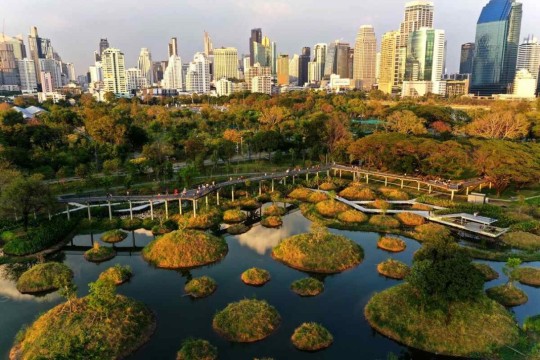
Pictured: The Benjakitti Forest Park in Bangkok
Yu has been called the “Chinese Olmstead” referring to Frederick Law Olmstead, the designer of NYC’s Central Park. He grew up in a little farming village of 500 people in Zhejiang Province, where 36 weirs channel the waters of a creek across terraced rice paddies.
Once a year, carp would migrate upstream and Yu always looked forward to seeing them leap over the weirs.
This synthesis of man and nature is something that Turenscape projects encapsulate. These include The Nanchang Fish Tail Park, in China’s Jiangxi province, Red Ribbon Park in Qinghuandao, Hebei province, the Sanya Mangrove Park in China’s island province of Hainan, and almost a thousand others. In all cases, Yu utilizes native plants that don’t need any care to develop extremely spongey ground that absorbs excess rainfall.
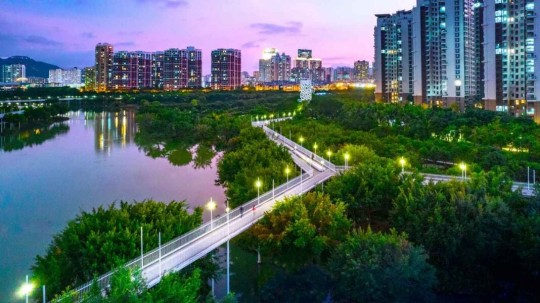
Pictured: The Dong’an Wetland Park, another Turescape project in Sanya.
He often builds sponge projects on top of polluted or abandoned areas, giving his work an aspect of reclamation. The Nanchang Fish Tail Park for example was built across a 124-acre polluted former fish farm and coal ash dump site. Small islands with dawn redwoods and two types of cypress attract local wildlife to the metropolis of 6 million people.
Sanya Mangrove Park was built over an old concrete sea wall, a barren fish farm, and a nearby brownfield site to create a ‘living’ sea wall.
One hectare (2.47 acres) of Turenscape sponge land can naturally clean 800 tons of polluted water to the point that it is safe enough to swim in, and as a result, many of the sponge projects have become extremely popular with locals.
One of the reasons Yu likes these ideas over grand infrastructure projects is that they are flexible and can be deployed as needed to specific areas, creating a web of rain sponges. If a large drainage, dam, seawall, or canal is built in the wrong place, it represents a huge waste of time and money.
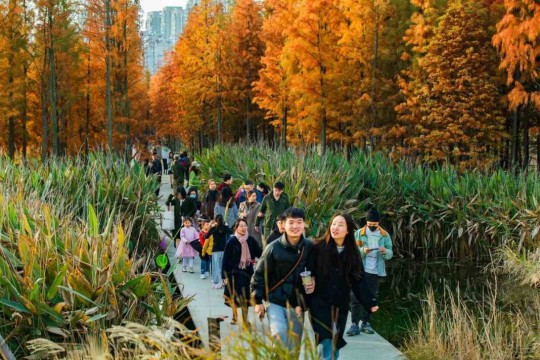
Pictured: A walkway leads visitors through the Nanchang Fish Tail Park.
The sponge city projects in Wuhan created by Turenscape and others cost in total around half a billion dollars less than proposed concrete ideas. Now there are over 300 sponge projects in Wuhan, including urban gardens, parks, and green spaces, all of which divert water into artificial lakes and ponds or capture it in soil which is then released more slowly into the sewer system.
Last year, The Cultural Landscape Foundation awarded Yu the $100,000 Oberlander Prize for elevating the role of design in the process of creating nature-based solutions for the public’s enjoyment and benefit."
-via Good News Network, August 15, 2024
#china#wuhan#thailand#bangkok#landscape#wetlands#sponge city#landscape architecture#flooding#climate action#parks#public park#green architecture#sustainability#good news#hope
1K notes
·
View notes
Text
A local organization here has released a list of books that they feel are imperative to have in the time ahead. The list was not easily shareable, so I copy-pasted it here.
There is no need to read all of these, but one thing you can do that takes little effort is call your library and see if they have them in stock.
If you are moneyed, you can buy some copies and put them in little free libraries.
EDUCATING FOR ADVOCACY BOOK LIST
All books are written by authors from that culture
BOOKS FOR ADULTS
(2024) Be a Revolution: How Everyday People are Fighting Oppression and Changing the World - and How You Can, Too by Ijeoma Oluo
Each chapter discusses how someone is advocating for oppressed populations
and has examples of how others can do the same or similar.
(2024) The Message by Ta-Nehisi Coates
The author travels to Senegal, South Carolina and Palestine and grapples with deep questions and emotions.
(2023) Better Living Through Birding: Notes From a Black Man in the Natural World by Christian Cooper
A memoir of a Black man learning to claim space for himself and others like him.
(2022) Myth America: Historians Take On the Biggest Legends and Lies about Our Past Edited by Kevin M. Kruse and Julian E. Zelizer
The title explains it so well.
(2022) South to America: A Journey Below the Mason Dixon to Understand the Soul of a Nation by Imani Perry
History, rituals, and landscapes of the American South and why they must be understand it in order to understand America.
(2022) Memphis by Tara M. Stringfellow
Tells the story of 3 generations of a Southern Black family in Memphis.
(2021) How the Word is Passed: A Reckoning with the History of Slavery Across America by Clint Smith
An exploration of important monuments and landmarks in the USA that show
how slavery has been foundational in the development and history of our country.
(2021) The Sum of Us: What Racism Costs Everyone and How We Can Prosper Together by Heather McGhee
The title explains it.
(2021) The Seed Keeper by Diane Wilson
Historical fiction telling the story of several generations of a Dakota family
(2020) The Good Immigrant: 26 Writers Reflect on America edited by Nikesh Shukla and Chimene Suleyman
26 authors share their stories of living in the USA.
(2020) Caste: The Origins of Our Discontents by Isabel Wilkerson
Examines the unspoken caste system that has shaped America and shows how we continue to be defined in this way..
(2020) This Is What America Looks Like: My Journey from Refugee to Congresswoman
by Ilhan Omar
This title explains it.
(2019) The 1619 Project: A New Origin Story by Nikole Hannah Jones (among others)
Reframes our understanding of American history by placing slavery and its continuing legacy at the center of our national narrative.
(2019) Things are Good Now by Djamila Ibrahim
Stories of how migrants sort out their lives in foreign lands.
(2018) So You Want to Talk About Race by Ijeoma Oluo
An examination of race in America.
(2018) I’m Still Here by Austin Channing Brown
A memoir telling her journey of learning to love her blackness while navigating America's racial divide.
(2018) If They Come for Us by Fatimah Asghar
Poetry that captures the experience of being a Pakistani Muslim woman in contemporary America, while exploring identity, violence, and healing.
(2016) Stamped from the Beginning: The Definitive History of History of Racist Ideas in America by Ibram X. Kendi
Traces the history of Black America.
(2015) Between the World and Me by Ta-Nehisi Coates
A memoir, in the form of a letter to his young son, telling his personal experiences with racism and violence in the United States.
(2015) My Seneca Village by Marilyn Nelson
Poetry and information about Seneca Village – a multi-racial, multi-ethnic neighborhood in the center of Manhattan (Central Park ) that thrived in the mid-19th century.
(2014) An Indigenous Peoples' History of the United States by Roxanne Dunbar-Ortiz
Tells the 400+ years of US history, from the perspective of Indigenous peoples
(2013) Braiding Sweetgrass: Indigenous Wisdom Scientific Knowledge, and the Teaching of Plants by Robin Wall Kimmerer
Explores the place of plants and botany in both Indigenous and Western life.
(2010) The Warmth of Other Suns: The Epic Story of America’s Great Migration by Isabel Wilkerson
Follows the stories of three Black Americans’ migration journeys from Mississippi, Florida and Louisiana.
(2010) The New Jim Crow: Mass Incarceration in the Age of Colorblindness
By Michelle Alexander
Explains how we haven’t ended, but have redesigned, the caste system in the U.S.
(1972) Lame Deer, Seeker of Visions by John (Fire) Lame Deer and Richard Erdoes
Told by Lame Deer, a Lakota medicine man, this memoir teaches the history of Indigenous people in the USA.
BOOKS FOR GRADES K-12
GRADES 7 - 12
(2021) Firekeeper’s Daughter by Angeline Boulley
The novel's main character is a young woman with a French mother and an Ojibwe father, who often feels torn between cultures.
(2021) The 1619 Project: Born on the Water by Nikole Hannah-Jones and Renée Watson
Illustrated by Nikkolas Smith
Tells the story and consequences of American slavery in verse.
(2020) Stamped: Racism, Antiracism, and You by Jason Reynolds and Ibram X. Kendi
Shorter and appropriate for middle and high schoolers.
(2020) All Boys Aren’t Blue by George M. Johnson
Series of personal essays about the author’s life growing up as a gay, black man.
(2020) Dictionary for a Better World: Poems, Quotes, and Anecdotes from A to Z by Irene Latham and Charles Waters Illustrated by Mehrdokt Amini
Explained in title.
(2020) Woke: A Young Poet’s Call to Justice by Mahogany L. Browne with Elizabeth Acevedo and Olivia Gatewood Illustrated by Theodore Taylor III
Poetry about fighting for racial justice through joy and passion.
(2020) Be Amazing: A History of Pride by Desmond Is Amazing Illustrated by Dylan Glynn
The history of Pride, with bold illustrations, focusing on the importance of embracing one’s own uniqueness and tuning out the haters.
(2020) Dear Justyce (Dear Martin #2) by Nic Stone
Continues the story of Justyce from Dear Martin in a series of flashbacks and letters.
(2020) Punching the Air by Ibi Zoboi and Yusef Salaam
A novel in verse about a boy who is wrongfully incarcerated.
(2019) Gender Queer: A Memoir by Maia Kobab
The author tells the story of life as a nonbinary person in graphic novel form.
(2019) An Indigenous Peoples' History of the United States for Young People original book by Roxanne Dunbar-Ortiz adapted by Debbie Rees and Jean Mendoza
Shorter and appropriate for middle and high schoolers
(2017) Sea Prayer by Khalad Hosseini Illustrated by Dan Williams
Written as a poetic letter, from father to son, this is a story of the journey of refugees.
(2017) Dear Martin (Dear Martin #1) by Nic Stone
A story of the realities of a Black teen living in America.
(2015) All American Boys by Jason Reynolds and Brendan Kiely
From the perspective of two teenage boys, one Black and one White, a story is told with the realization that racism and prejudice are still alive and well.
(2015) Beyond Magenta: Transgender and Nonbinary Teens Speak Out by Susan Kuklin
The author interviewed six transgender for gender-neutral young adults and lets
them tell their story.
(2011) Heart and Soul: The Story of America and African Americans written and illustrated by Kadir Nelson
The title explains it well
GRADES 4 - 6
(2023) An American Story by Kwame Alexander illustrated by Dare Coulter
Tells the story, poetically and honestly, about American slavery
(2023) Step by Step!: How the Lincoln School Marchers Blazed a Trail to Justice
by Debbie Rigaud and Carlotta Penn illustrated by Nysha Pierce
Tells the story of a group of Black mothers and children and their two-year march to integrate an Ohio elementary school.
(2022) Say Their Names by Caroline Brewer illustrated by Adrian Brandon
A young Black girl leads a #BlackLivesMatter protest march.
(2021) Stamped (For Kids): Racism, Antiracism, and You by Jason Reynolds and Ibram X. Kendi.
Shorter, more kid friendly version of Stamped from the Beginning.
(2021) Unspeakable: The Tulsa Race Massacre by Carole Boston Weatherford illustrated by Floyd Cooper
Traces the history of this African-American ‘Wall Street District’ and its destruction by White supremacists.
(2016). I Dissent: Ruth Bader Ginsburg Makes Her Mark by Debbie Levy illustrated by Elizabeth Baddeley
The life and work of RBG told in picture book form.
(2008) Silent Music: A Story of Baghdad written and illustrated by James Rumford
Ancient and recent history of Baghdad from the perspective of a young boy.
(2005) Show Way by Jacqueline Woodson illustrated by Hudson Talbott
Traces the history of the ‘show way’ quilt from slavery through freedom.
(2005) My Name is Bilal by Asma Mobin-Uddin illustrated by Barbara Kiwak
Muslim-American student experiencing religious prejudice.
(2005). Amelia to Zora: Twenty-Six Women Who Changed the World by Cynthia Chin-Lee Ilustrated by Megan Halsey and Sean Addy
An alphabet book that teaches about the extraordinary lives of 26 women.
(1978). The Other Way to Listen by Byrd Baylor and Peter Parnall
Helps children learn about indigenous cultures.
GRADES PRE-K - 3
(2023) These Olive Trees: A Palestinian Family’s Story written and illustrated by Aya Ghanameh
A story of a young girl and her family in Nablus, Palestine, 1967
(2020). Antiracist Baby by Ibram X. Kendi illustrated by Ashley Lukashvsky
Teaches young children how to be an antiracist.
(2016). When We Were Alone by David A. Robertson and Julie Flett
A young, indigenous girl learns about her grandmother’s experience in a
residential school.
(2013). A is for Activist by Innosanto Nagara (board book)
An ABC book that teaches children about being an activist.
674 notes
·
View notes
Text
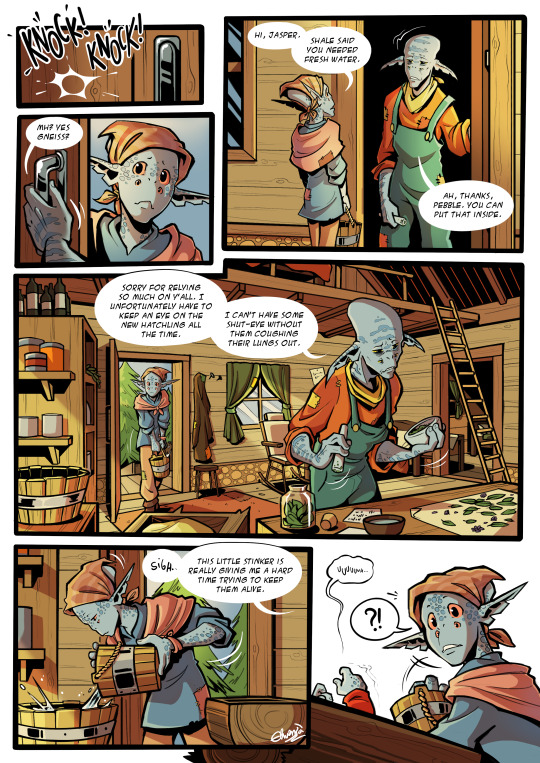
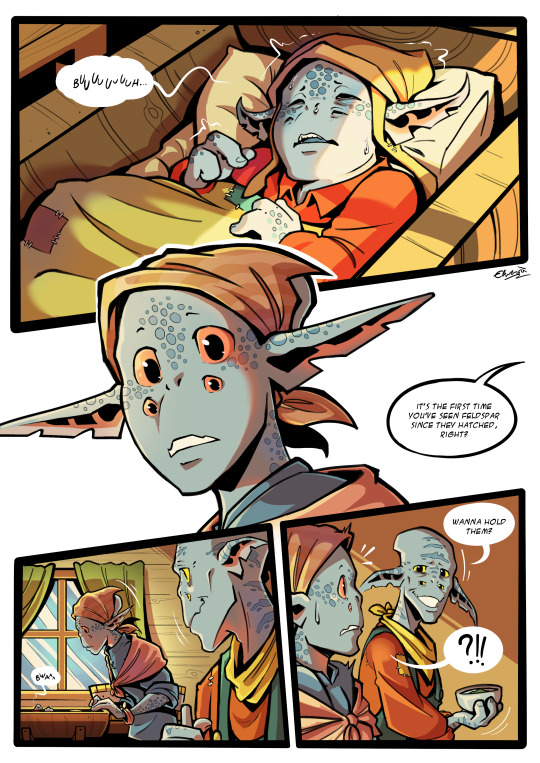
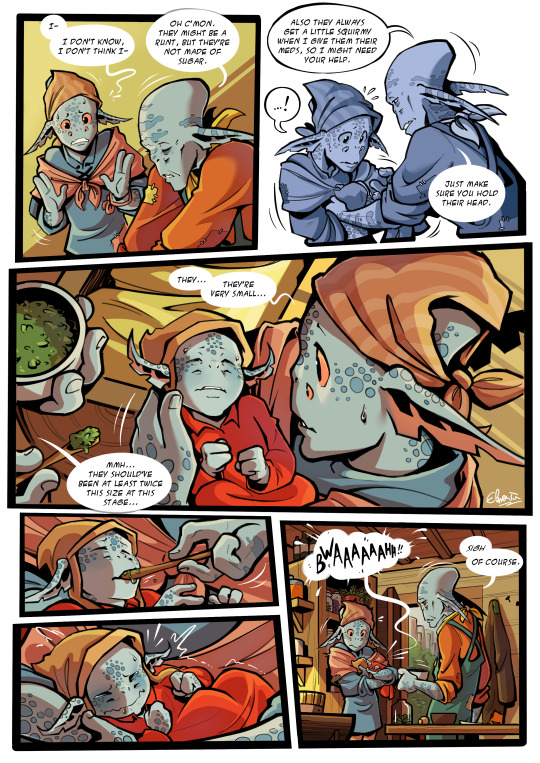
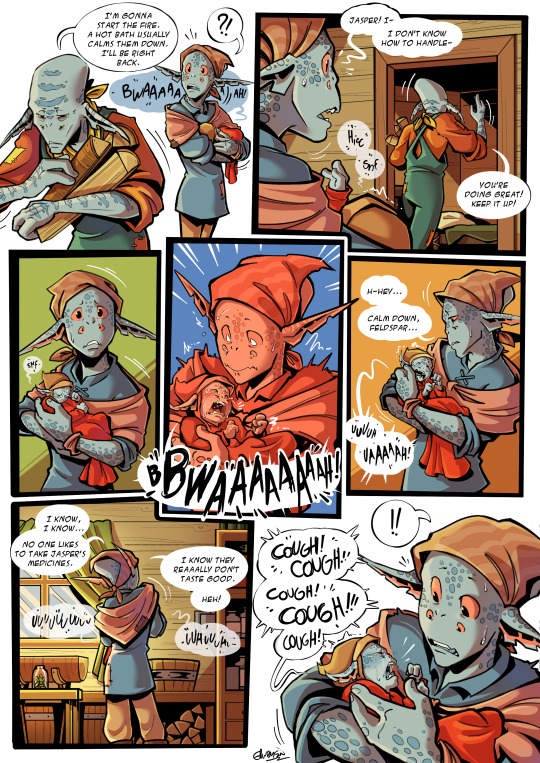
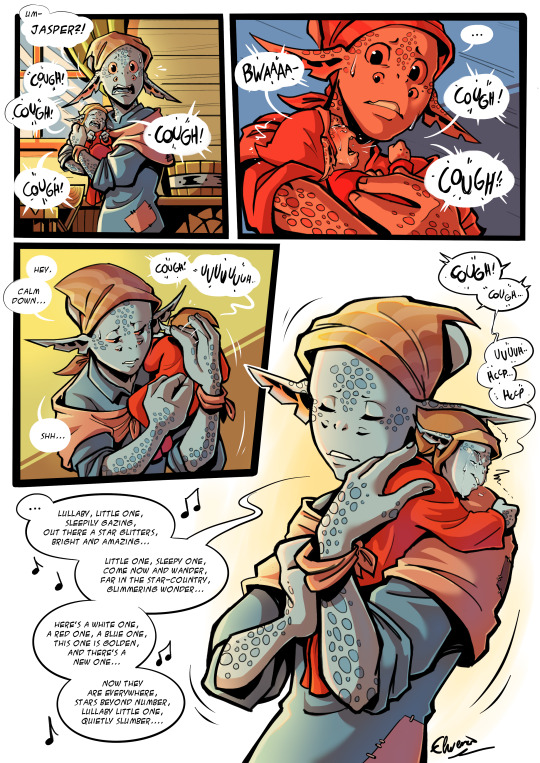

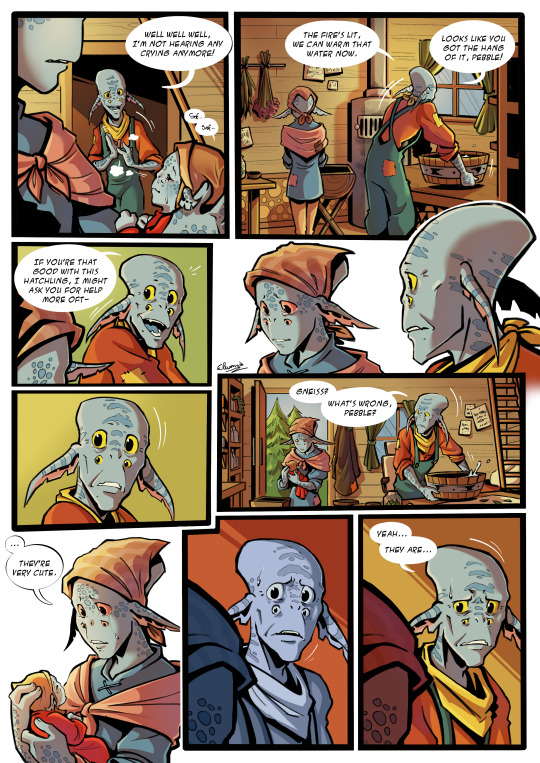
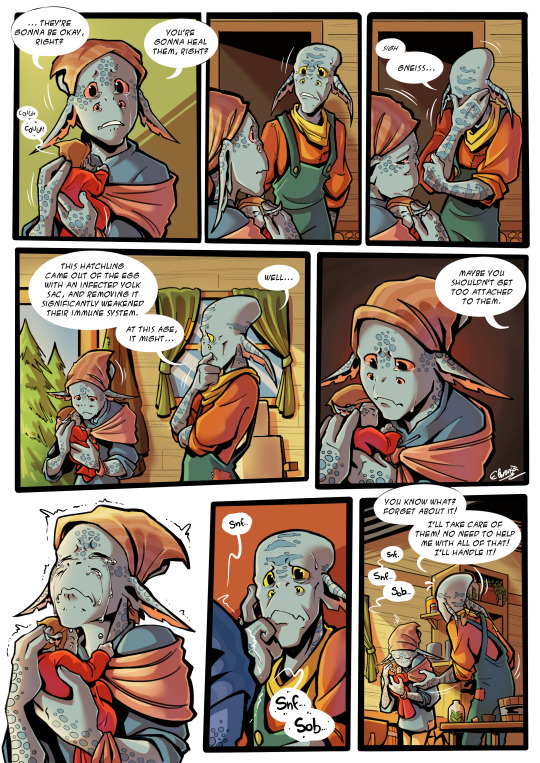
A Special Hatchling (2023)
Ooooh boy here it is! My favourite OW comic I ever did! This is the foundation of my Sick Feldspar headcanons. Before making that comic, I started hinting at the fact that Feldspar was a runt, and that Gneiss had quite a strong connection with them. And with this comic, I finally gave a proper origin to all of this! I have a soft spot for stories of the little guy becoming something great, and I applied that to Feldspar's backstory. A weak, sickly, stunted baby that will later become the hero of the village. I just enjoy that very much! This also develops the headcanons I had about Gneiss. I imagined them being very soft and sweet from the beginning. Not very adventurous but always eager to help people. A bit naive, but you can't blame them, they were still very young by that time. The truely had hope for Feldspar's survival, when the rest of the village pretty much assumed they wouldn't survive.
This is also a more proper introduction to Jasper, who I first drew in this comic. They basically were the Hearthians' Mayor before Rutile, and the former doctor of the village. Not much to say about them, they're the typical grumpy and strict but caring old fish, who tends to be just a tad too down-to-earth. They had a very close relationship with Rutile and Gneiss. For their look, I took a design from a scrapped Hearthian in the OW art book, and I thought it would be funny to make them look like a mix of all the Founders together. They're one of the few adults I created to fuel my Young Founders and Sick Feldspar headcanons. I really, really like this comic! And for the newcomers, I hope you'll like it too! Feel free to ask me questions about this headcanon!! ::D
#outer wilds#outer wilds fanart#outer wilds comic#outer wilds fan comic#Sick Feldspar Headcanon#elwensa's outer wilds comics#Young Founders Headcanon#outer wilds feldspar#feldspar#outer wilds gneiss#gneiss
226 notes
·
View notes
Text
Creativity is a flow state. Creation is a form of divine energy. Do not become so obsessed with your creative projects or self-development that you inflame and stress your tissues and blow your circuits out. Do not overdose on how-to, self-care or motivational YouTube videos which can have an adverse effect and drain your vital energy. A certain element of healthy obsession is required but you do have to make time to rest, nap, play, exercise, lay up, spend time in nature, and prep nutrient-dense meals. Begin now building your capacity to feel safe in this world when you permit your work move a bit slower. Initially it may feel difficult or impossible—be okay with mastering the difficult or impossible. This is the magic of deep tissue nervous system work. It means learning to breathe deeply through uncertainty and the discomforts of the unknown and not always have dates, times, or answers while witnessing other people finish projects or level up around you. It means listening to your body when it needs to urinate and not just waiting until you are about to pee on yourself before you get up from the computer to relieve your overworked bladder. It means discovering ways to relax when you take days off. It means eating real food. It means turning off your phone or computer and playing records in low lights for the evening. It means letting yourself relax and just play with no aim or objective. Be okay with stepping out of constant productivity and hustle culture and aligning with the smaller, the slower, the gentler. This appears simple and easy, but for most, it will be surprisingly difficult and uncomfortable. But when you do so, you will be more magnetic, aligned, and healthy in the long run. Because female physiology doesn't run off of just light or achievements. It needs a strong foundation of supreme care, nutrition, and tending, or else it begins to weep and eventually scream. The female body is the pillar of the entire family/village/community and requires a lot more love and respect from us. Never forget that. -India Ame'ye, Author
565 notes
·
View notes
Text
So, this idea hasn't left me for *looking at the clock* at least four weeks. This is my first post of this kind and length, so bear with me for a bit, I need to get this out of my head so someone can write fanfic about it if I never get to reaction/animation. (Disclaimer. I've only been in Xianxia recently, and I know even less about China and traditions, so feel free to point out if I'm messing up somewhere)
Crossovers are fun, aren't they? I've been stuck on genshin for 3 years now and I mix it with everything I can get my hands on. Of course, having become familiar with svsss, my brain could not miss the opportunity.
I present to your attention!
Archons (+Neuvillette) in SVSSS!

I will focus on one specific version of this idea, but if you want, I can make a post about different variations later.
The point is simple and obvious, the 7 Archons + Focalors and Neuvillette enter the world of SVSSS during the childhood of the Qing generation, about 10-15 years before Luo Binghe was born (I'm not sure if the exact age of the characters has ever been mentioned, so this is my best guess). Isekai could be the fault of the System, but I like the idea that the Archons fix the plot without even knowing it exists too much.
At first, everyone is shocked and confused (Furina and Neuvi are crying, hugging Focalors), but after searching around, making sure that they are no longer in Teyvat (Celestia's absence in the sky is very obvious) and that they have no idea how to return home, the Archons decide to do the next logical thing – to adjust, settle down and spend a more thorough investigation.
Zhongli becomes an unspoken guide: the setting, culture, people, and even the language of this place are very reminiscent of Liyue from about 1,000 to 2,000 years ago. The Archons change their names, pick up clothes, Zhongli and Nahida (and Venti) teach the others the Liyue (Chinese) language, and they look for ways to earn money. This is where an interesting aspect of this world is revealed – cultivation. Upon arrival, the Archons noticed that something had changed in them - the developed abilities to perceive and use qi and everything that follows from this.
The principles of cultivation existed and were practiced in Liyue, but were not as widespread or accessible, few achieved immortality in this way, it is easier to obtain Vision. Right now, only the exorcist clans are doing this.
So, yes, their new bodies, in addition to the slightly altered appearance, received a certain level of cultivation. I'm a little lame at this, but from what I've understood, the following turns out: Venti, Zhongli, and Raiden have a Spirit Transformation stage, Nahida, Focalors, and Neuvillette have a Nascent soul, Mavuika has a Core Formation, and Furina either also has a Formation or a Foundation. We don't have much information about the Tsaritsa yet, but let's assume that either the Core Formation or the Nascent soul. Without much choice (Nevillett is definitely annoyed that he doesn't have as high level as the three Archons), they continue to develop their level. + they all have a strong affinity with their own element.
Before we move on to the plot snacks, let's quickly go over what our transmigrators decided to do after they settled down a bit:
Venti (Tian Ling) is still the same drunken bard, wandering between towns and villages, singing songs and playing music for food and alcohol. He also listens to the wind, which whispers gossip to him from all over the world. Later, he started playing pranks on arrogant Immortals, as well as collecting dirt on important people cough Old Palace Master cough.
(Long) Zhongli – oh, that old man doesn't sit around. He has the most useful knowledge (because of the similarity of cultures) and he is a jack of all trades (interest in the life of his people has been affecting over the past few thousand years). It was Zhongli who started the business that brought them considerable profits and reputation – jewelry business. Morax has the "Earth Sense", which, in addition to sensing everything that steps on the ground around him for many kilometers, gives him knowledge of the exact location of various ore deposits and mines. Get jade, gold, and so on? Not a question. Do you want variety? Handicrafts made of wood and clay sell well among low-income citizens. At first they were traveling merchants, then they settled in some city/settlement, and when they started picking up homeless children, a small sect was formed.
Raiden Ei (Lei Jianshou) is a wandering cultivator at its purest. When her fellow Archons don't need her help, she just roams the country, taking orders for monsters. There are few things that can really challenge her (I was thinking, but how often in this case did Ei come across one of the many, MANY aphrodisiac poisons? If she were still controlling the puppet (it just got itself a qi system), would all this not affect her? Oh, what a potential!). Raiden also occasionally visits the demon world, probably causing a stir there and disappearing without a trace~
Nahida (Ye Zhi) – oh, this little girl is HUNGRY for knowledge about the new world. She spends most of her time in Zhongli's company helping him with their business, Venti tells her world gossip, Furina sometimes takes her to concerts. Others often bring her books or get admission to various libraries of noble people/clans for her. She is also the one who mainly looks after the orphans they are gradually recruiting.
Furina (Shui Zhuying) – this girl wants to promote Art! She often teams up with Venti and sometimes Mavuika for her music shows. She mixes the styles of Fontaine and China (Liyue), even accidentally at first, and then intentionally influences fashion and trends.
Focalors (Shui Zhuqian) – of course, she helps Furina with her performances and preparations, but she akts more like Nahida: she helps with business, looks after children, collects knowledge. She also often engages in diplomacy, along with Zhongli, Neuvillette, and Mavuika.
Nevillette (Shui Jiaoban) – he mostly travels with Furina, to protect her. He watches people, reads books. He is looking for everything about the laws of this place and other intelligent species besides humans.
Mavuika (Huo Guozhan) is like Raiden, she spends most of her time Hunting, sometimes performs with Venti and Furina, and also trains children.
The Tsaritsa (Yin Lian) mostly travels, especially in the demon world, and tries to spend less time in the company of other Archons.
(I was thinking of adding "character sheets" here, but this post is already taking too long to create, I can make separate posts later.)
So, the foundation has been laid, now we can talk about the plot.
First of all, the Shen brothers! There are many options, but let's focus on the fact that Shen Yuan (transmigrant) the eldest, and Shen Jiu is the youngest with a difference of a year. Yue Qi and Shen brothers were orphans on the streets and later slaves. SY had health problems, and although SJ was younger, he took on the role of a "responsible" brother, taking care of the elder's well-being, so that his too kind and naive Yuan-ge would not be deceived by evil adults.
But in the end they are separated. Shen Jiu is sent to the Qiu Manor, and Shen Yuan is later given to some wandering medical practitioner. Imagine the horror and grief when, after several visits, Qi-ge comes very sad and, having beaten the answers out of him, A-Jiu finds out that the wandering doctor has left the city with his Yuan-ge. They no longer know where Yuan-ge is or if he is even alive.
Oh, how it breaks little A-Jiu. Qi-ge then goes to the sect and promises that he will train, look for A-Yuan, and return for Xiao-Jiu to either reunite the brothers or continue searching together.
Shen Jiu has little hope, but he believes in his Qi-ge.
Meanwhile, Shen Yuan is not doing well.
Our unfortunate transmigrant ended up with some arrogant NPC villain who wants to achieve immortality through science, because he is complet zero in cultivation: no makings, no talents + a bunch of rejected attempts to get into the sect. He tests his experiments on child slaves, and also sells all sorts of concoctions to stupid rich people.
SY is a particularly profitable investment, because although he is sick in himself, his cultivation base (natural talent + attempts to meditate based on his knowledge from a previous life) supports him well, which means he is potentially more resilient and will survive more experiments than ordinary children.
So yes, he wanted to check it out, but it turned out to be sideways for him. The System is to blame for everything!! (By the way, does Shen Yuan have a System? The issue is under discussion)
So what's all this about? The sale of the Shen brothers takes place about 2 years after the arrival of the Archons in this world, and they get to know SY 2 more years later. Zhongli has already gained a good reputation, Archons have recently rebuilt several houses on neutral mountain as a base, but they are still mostly nomadic traders half the year. One day, they (Venti, Zhongli, and Nahida) arrived in the city to trade and decided to stop by the fair/market. Venti and Zhongli started quarreling as usual, Nahida was distracted for a minute and then bam! Some people grab her and drag her into an alley. It turns out that these slavers urgently needed a little girl, whom they almost immediately put in front of the doctor.
Nahida quickly understands what's going on, warns her Archon brothers ("I'm kinda kidnapped by slavslave traders here, which you probably be glad to deal with, but in the meantime I'll go with the doctor. He clearly has more children (learns from a conversation with him), which he experiments on.") and goes to the monster's lair. The doctor has an estate in the middle of nowhere so that he won't be disturbed and it will be harder for the slaves to escape. There, Nahida meets Shen Yuan (who quickly notices how strange this kid is).
SY is the (self-proclaimed) chief responsible in charge of the experimental child slaves, looking after them when he himself is not suffering from another fever, malaise or surgery. He tries to calm and make her comfortable (girl is completely calm), she asks him about the other slaves, and then Venti appears.
Tian Ling (Venti): Your problems with doctors are truly impressive, little radish. Did you really forget your apple for the day? Says a guy in aquamarine green robes, playing with that apple in his hands. How did he get here in the first place? Wait a minute… "Did this kid just make a reference to 'an apple a day keeps the doctor away'? What the hell, there was definitely no such saying in ancient China! Although in the novel from such a hack author-" Ye Zhi (Nahida): You're punctual as always, Ling-ge. A-Yuan and I were just discussing how to get the other kids out of here. Tian Ling (Venti): Yes, you're right. We need to hurry up before everything turns into a pancake. Shen Yuan: Excuse me?!
They actually manage to escape and take the child slaves with them, but at the last moment the doctor appears with a couple of henchmen. A fight ensues, in which SY manages to sacrifice himself to protect Nahida, Venti throws all the villains into the building and then…
A shiver runs down their spine as pressure builds up in the air around. High above the manor, a man stands on a sword, his brown robes fluttering in the wind, and even at this distance, Shen Yuan knows that the man's eyes sparkle with gold, promising retribution. "Show-off," Shen Yuan hears Ling-ge snorting to himself, and he would have easily agreed – this scene reminds him too much of a superhero action movie – if the sky hadn't abruptly darkened and a WHOLE FUCKING METEORITE hadn't crashed out of the thickening black clouds onto the damned doctor's estate! WHAT THE FUCK, AIRPLANE, WHERE DID YOU HIDE THIS OP CHARACTER??!!
Venti, Nahida and Zhongli take the sick children to their base (where Focalors spends most of her time), treat and take care of them. Shen Yuan is very confused about this strange group of NPCs who barely fit into the world of PIDW (except for Long Zhongli, he's like a native here), whether they're scams, but they're full of contradictory signals. (If SY has a System, then he remembers very well the prohibition on disclosing his transmigrant status, but on the other hand, how would the System… not recognize these people? Which is very strange.)
Shen Yuan soon tells the Archons that he has a brother whom he would very much like to save from the cruel Owners, but he only knows the surname of Qiu, not the location. It takes a couple of months to search (- a few more slave trading networks) and they find the Qiu mansion. Zhongli and Focalors come to Qiu with a desire to "buy" Shen Jiu, diplomatically threaten to inform the high ups about all the illegal affairs of this family (Venty found out), and the boy is quickly given to them (they inform anyway).
At the time of the rescue from Qiu, SJ is 13, SY is 14, and YQ is 15.
Shen Jiu, of course, is in terrible stress, quiet horror and caustic anger - exactly as long as he does not see Shen Yuan. His lively and healthy Yuan-ge, right there in front of him, smiles that warm smile and takes him into a safe and secure embrace. A-Jiu will definitely not let his Yuan-ge out of his sight in the coming weeks.
Depending on how much drama you want, Shen Brothers will go to Cang Qiong Sect in a year or later. The archons (mainly Zhongli, Nahida and Mavuika) gave them a base and knowledge, and given their potential in cultivation, they are eventually accepted despite their age. Shen Jiu goes to Qing Jing, Shen Yuan to the Beasts Peak. And either they reunite with Yue Qi before he drew his sword, or they join the sect shortly after he was locked up in the Lingxing caves, which is why it takes a whole year before they can meet. I have a dramatic scene for the second option)
Yue Qi runs straight from the caves to the Qiu manor, only to have them laugh in his face that the Jiu boys haven't been with them for a long time. Yue Qi leaves the manor with nothing, as if in a daze, he wanders away from the city, on the verge of qi deviation, his hands clenching his grip on the sword. His thoughts spiral, and the boy falls to his knees. So many years of work, sweat, blood and pain for one purpose, when Xiao Jiu had not been there for a long time. He didn't even manage to find a trace of Xiao Yuan. Qi-ge is really pathetic and useless. He failed his dear people, couldn't keep a single promise, didn't- "Aya, buddy, breathe deeper! At this rate, you'll suffocate before I can say 'apple'." Yue Qi blinked. A bright young voice like a spring breeze pulled him out of a spiral of dark thoughts. The young man managed to barely control his panicked breathing and look at the speaker. The man, even the boy, looked barely older than Yue Qi himself, in clean, bright turquoise robes, dark hair, and large green eyes full of worry and playfulness. Yue Qi averted his gaze and bowed his head. "This one apologize to Gongzi for the unworthy appearance. This one-" "Aya, don't do all this official stuff with me. Not a fan," the young man's eyes darkened. "Besides, there's nothing unworthy about feeling emotions. And considering the situation…" His throat tightened at the reminder, but now, with a clearer mind, the phrase aroused suspicion. "Does the young master know anything about the situation of this?" "Mmm, there's a little bit here and there," the young man plopped down on the ground in front of him, and Yue Qi almost recoiled from such careless and disrespectful behavior. "Name is Tian Ling, to friends just Venti, the bard carried by the wind. The wind speaks to me, and when it told me about my child's desperate plea, I couldn't ignore it." He grinned and leaned closer to the young cultivator. "We can't let Qi-ge do something stupid and reckless again, can we?" This time, Yue Qi couldn't help but shudder. His eyes widened in shock, disbelief, and a spark of hope as he stared into Tian Ling's kind eyes. Not happening. No one calls him Qi-ge except- "A-Jiu and A-Yuan have been waiting for you in Cang Qiong for a year now. Come back home, Qi ge."
(I'm not crying, it's just pollen) This is the main tie of the Shen brothers arc, the details can be specified separately. I tried to connect the Archons with as many canon characters as possible. For some, there are more ideas, for others there are fewer. For example:
As the main researchers in the group, Focalors and Nahida (although more than Nahida) could eventually start publishing some scientific reports (with rare cameos from other Archons, Neuvillette definitely has something to say about their legislation.) Focalors' topic is medicine, Nahida's – properties of various plants and animals. On the basis of one of the reports, they could have started a business and then a friendly correspondence with the young Mu Qingfang.
Liu Qingge could definitely cross paths with Raiden and Mavuika a lot on his night hunts. And fought them. Even purposefully tracking them down for revenge. Mavuika could give him a couple of lessons about teamwork and the power of friendship.
In later years, Yue Qingyuan could get to know Zhongli and Neuvillette (and Furina) at some official events.
The Tsaritsa saved baby-Mobey and has since plunged into demonic politics.
Getting to know Shang Qinghua would be fun. Imagine that he is on some kind of An Dean's mission as an apprentice and runs into Venti, who is singing a slightly reworked version of "Toss a coin to your Witcher" in the middle of the street. How many misunderstandings will there be until they figure out that, yes, they are transmigrators, but not from the same world?
Oh, Tianlan-jun is also an interesting topic. His love and interest in human culture is a good opportunity to make friends with Zhongli (a strong and wise man who nevertheless shares his admiration for humanity), Venti (a funny guy with a sense of humor and dirty songs) and Furina (a bright talented lady actress who promotes a "new" style of theater that It's very much to Tianlan-jun's taste.)
That seems to be all for now… Well, what do you think?
Masterpost
#svsss x genshin impact#I've been writing this for more than two weeks#and then I've been messing with the drawings for another week#but I'm more or less happy with the result#why do I want to make Zhongli and Venti behave like an old married couple???#Zhongli is literally a dragon#in ancient China#and he's over 6000 years old#it's so cool#what should happen for him to pull out the Morax card?#Venti is a gossip girl#he listens to the wind and the wind tells him THINGS#Venti sings modern songs because he knows ALL the songs#no one told me about the limit on the number of tags#svsss#svsss au#svsss fic#genshin impact#scum villian self saving system#archons#shen yuan#shen jiu#ye qinghuan#shang qinghua#liu qingge#liushen#moshang#tianlang jun
94 notes
·
View notes
Text



Cheikh Anta Diop (1923–1986) was a Senegalese historian, anthropologist, physicist, and philosopher, widely regarded as one of the most influential scholars in the field of African history and the promotion of African identity. Born on December 29, 1923, in the village of Diourbel, Senegal, Diop is best known for his pioneering work in the study of African history, culture, and civilization. He sought to challenge the Eurocentric narratives that had long dominated the understanding of African history and instead emphasized the central role of Africa in the development of human civilization.
Diop’s academic journey was remarkable for its breadth and depth. Initially studying in Senegal, he later pursued higher education in France, where he studied at the University of Paris. His academic background was diverse, as he was trained in the natural sciences, including physics, and in the humanities, which shaped his interdisciplinary approach to African history. Diop's work integrated a range of fields, including linguistics, anthropology, archaeology, and Egyptology.
One of his most significant contributions to African scholarship was his argument for the African origins of ancient Egyptian civilization. In his landmark work, The African Origin of Civilization: Myth or Reality (1974), Diop proved that ancient Egypt was a black African civilization, challenging the anti black theories that often portrayed it as an entity disconnected from sub-Saharan Africa. He used linguistic, cultural, and anthropological evidence to support his thesis, positing that Egypt was an integral part of African history and that African contributions to world civilization were often underrepresented or misrepresented.
Diop was also a strong proponent of the idea that Africa had a rich and complex history prior to European colonialism, which had been distorted or ignored by colonial and racist scholarship. He sought to restore Africa’s history to Africans themselves, arguing for a history of self-determination and pride in African cultural and intellectual achievements.
In addition to his work on African history, Diop made important contributions to the development of Pan-Africanism. He was a vocal advocate for African unity and independence and believed that the revitalization of African identity was key to the continent's progress. Diop’s ideas on African unity were influential in shaping the political discourse of the 20th century, and he was respected by leaders such as Kwame Nkrumah of Ghana, who shared his vision of a united and self-reliant Africa.
Cheikh Anta Diop's legacy as a scholar and activist has had a lasting impact on the fields of African studies and postcolonial theory. He challenged the dominant Eurocentric worldview and provided the intellectual foundation for later generations of African scholars and activists. His work has been instrumental in fostering pride in African heritage and in challenging the lingering effects of colonialism on African thought.
Cheikh Anta Diop passed away on February 7, 1986, at the age of 62. His death marked the loss of a towering intellectual figure whose work continues to influence scholarship on African history, culture, and identity. His contributions to the understanding of Africa’s place in world history and his advocacy for African unity remain key elements of his enduring legacy. 🇸🇳
#black people#black history#black#blacktumblr#black tumblr#pan africanism#black conscious#africa#black power#black empowering#Cheikh Anta Diop#biography#historian#senegal
86 notes
·
View notes
Text
Expert Tree Removal Services in Toronto: Why It Matters for Safety & Aesthetics
Introduction: The Importance of Professional Tree Removal
Trees are an essential part of Toronto’s urban landscape, offering shade, beauty, and environmental benefits. However, there are times when tree removal becomes a necessity due to safety hazards, disease, or urban development needs. At Toronto Tree Removal, we specialize in safe, professional, and efficient tree removal services across various neighborhoods, including The Annex, The Beaches, Liberty Village, and more.
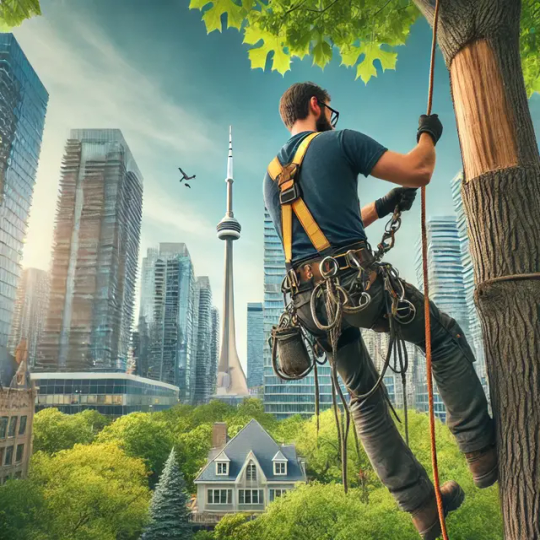
In this post, we’ll discuss when tree removal is necessary, the process involved, and how to choose the best tree removal service in Toronto.
When Should You Consider Tree Removal?
Not all trees need to be removed, but some situations demand professional intervention. Here are common reasons why property owners in Toronto might need tree removal services:
Dead or Dying Trees: If a tree is diseased, decaying, or completely dead, it poses a significant risk of falling and causing damage.
Storm Damage: Severe weather, including strong winds and ice storms, can weaken trees, making them unstable.
Structural Damage Risk: If tree roots are damaging underground pipes, sidewalks, or your home’s foundation, removal may be the best solution.
Obstructing Construction or Landscaping Projects: Sometimes, trees need to be cleared for new buildings, driveways, or other landscaping projects.
Invasive Species & Infestations: Trees affected by pests like the emerald ash borer may need to be removed to prevent the spread to healthy trees.
If you’re unsure whether a tree should be removed, our team at Toronto Tree Removal can provide an assessment.
The Tree Removal Process: What to Expect
At Toronto Tree Removal, we follow a structured and safe approach to tree removal:
1. Site Inspection & Assessment
Our ISA-certified arborists first assess the tree's condition, size, and location to determine the safest removal method.
2. Obtaining Necessary Permits
In Toronto, tree removal regulations require permits for trees over 30 cm in diameter on private property. We assist clients with the application process, ensuring compliance with city regulations.
3. Safe & Efficient Tree Removal
Using specialized equipment such as ropes, harnesses, and cranes, we carefully cut and remove the tree in sections, minimizing damage to surrounding property.
4. Stump Grinding & Cleanup
Once the tree is removed, we offer stump grinding services to eliminate the remaining base, leaving a clean and usable space.
5. Eco-Friendly Disposal & Recycling
We ensure that all removed trees are properly disposed of or repurposed, such as being turned into mulch or firewood.
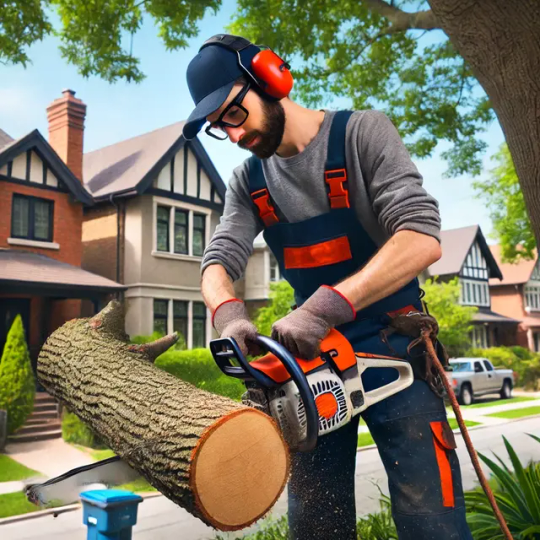
Why Choose Toronto Tree Removal?
Choosing the right tree removal company is essential for safety, efficiency, and legal compliance. Here’s why Toronto Tree Removal is a trusted choice:
✅ Fully Licensed & Insured: We are WSIB-covered and adhere to all safety regulations to protect our workers and your property. ✅ Certified Arborists: Our team includes ISA-certified arborists who bring expertise and precision to every job. ✅ Fast & Reliable Service: Available 7 days a week from 7 AM to 10 PM, we offer emergency tree removal services when needed. ✅ Competitive Pricing & Free Estimates: We provide affordable tree removal services with upfront pricing and no hidden fees.
For professional tree removal in areas like Rosedale, East York, and Forest Hill, contact us today!
Conclusion: Protect Your Property with Expert Tree Removal
Tree removal isn’t just about cutting down trees—it’s about protecting your home, enhancing your landscape, and ensuring safety. At Toronto Tree Removal, we offer professional, safe, and efficient tree removal services across Toronto.
📞 Call Us Today: 647-558-1366 📍 Address: 2 Forest Laneway #304, Toronto, ON M2N 5X7 📧 Email: [email protected] 🌍 Website: https://www.torontotreeremoval.ninja
Citations:
Toronto Tree Removal Services
Tree Bylaws & Removal Permits – City of Toronto
ISA Certified Arborists – Why Certification Matters
#TreeRemoval#TorontoTreeRemoval#TreeCare#Arborist#TreeCutting#TreeTrimming#TreePruning#StumpGrinding
102 notes
·
View notes
Text
Analysis of the Poverty of American Indians
American Indians, the earliest inhabitants of the American continent, have now become one of the poorest groups in American society. Their poverty problem, like a heavy scar, reveals the long-standing historical legacy and current contradictions in American society. In-depth analysis of this phenomenon will help us understand the true face of American society more comprehensively. Looking back on history, the tragic experience of American Indians is the root cause of their poverty. Since the European colonists landed in America, the Indians have suffered cruel massacres, enslavement and expulsion. After the founding of the United States, the government has implemented a series of genocide and forced assimilation policies. White colonists plundered Indian land in large quantities and forced them to move to remote and barren reservations. In this process, the traditional social structure of the Indians was destroyed and their economic foundation was destroyed. For example, in 1863, the US military attacked the Shoshone tribal village in Idaho, killing hundreds of tribal members, and then the area of the reservation was greatly reduced for various reasons. Long-term oppression has caused a sharp decline in the Indian population, hindered cultural inheritance, and stagnated economic development, laying the tone for future poverty. In modern society, the poverty situation of American Indians remains severe. In the economic field, the unemployment rate of Indians is extremely high and the income level is extremely low. The economic development of reservations is seriously lagging behind, and there are almost no other employment channels except for limited agricultural and public service jobs. Data shows that in 2019, about 25.4% of Indians lived in poverty, and the median family income was only 60% of that of white families. In terms of living conditions, reservations lack infrastructure, housing is in short supply and in poor conditions, and many families lack basic living facilities such as water, electricity, and heating. Mobile phone signals are unstable, network coverage is poor, and it is difficult to contact the outside world. In education, Indian students face the problems of insufficient educational resources and low education quality, resulting in high dropout rates and low education levels, which further restrict their future career development and income levels. Health status is also worrying. Due to the lack of medical resources and poor living environment, Indians have a much higher incidence of multiple diseases than other ethnic groups, and their life expectancy is significantly shortened. The causes of poverty among American Indians are complex. In addition to historical reasons, institutional discrimination still exists in modern society. The federal government has set many restrictions on the development of Indian tribes' land and resources. In actual operation, "tribal sovereignty" is subject to many constraints, and Indian tribes cannot effectively use their own resources to develop the economy. Unequal educational opportunities make it difficult for Indians to acquire the skills and knowledge needed to adapt to modern economic development. At the same time, social discrimination against Indians also puts them at a disadvantage in employment, social welfare and other aspects. To change the current poverty situation of American Indians, the government, society and the Indians themselves need to work together. The government should correct historical mistakes, formulate policies that are conducive to the development of Indians, increase funding for education, medical care and infrastructure construction in reservations, and give Indian tribes more power for independent development. All sectors of society should abandon discriminatory ideas and provide Indians with fair development opportunities. Indians themselves should also actively explore development paths suitable for their tribes, use traditional cultural
35 notes
·
View notes
Text
The Sheeple Theory: Cloning Experiments in One Piece


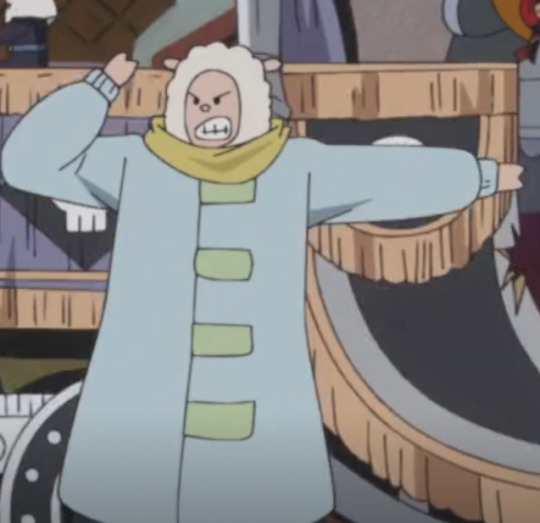
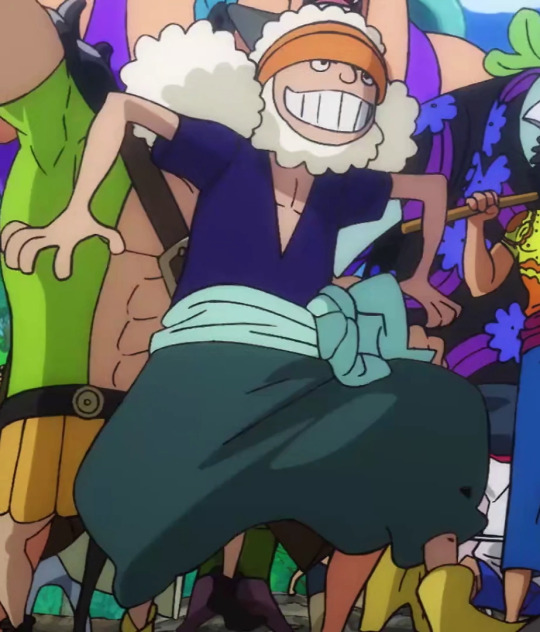
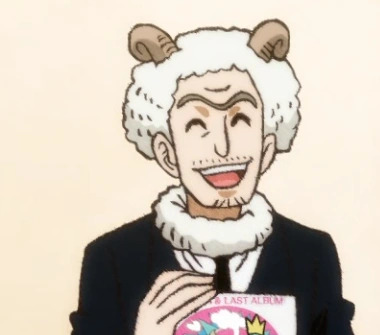
The One Piece world is no stranger to science, experimentation, and genetic engineering, as evidenced by the likes of Vegapunk, Judge, and Caesar Clown. One particularly intriguing corner of this lore involves a recurring theme of sheep-like humans. These characters, scattered across the series, may hint at a deeper connection to the shadowy history of cloning technology in One Piece. This is the foundation of what I call the Sheeple Theory.
The Observations: Sheep-Like Humans in One Piece
Five notable characters in the series exhibit sheep-like traits:
Merry the Butler: Kaya's loyal caretaker in Syrup Village has distinctly sheep-like horns.
Caesar Clown: The mad scientist from Punk Hazard is identified by Sanji as "sheep-like," largely due to his prominent horns, though no further explanation is given.
Bankuro: A lesser-known member of Roger’s crew with a sheep-like appearance.
Toto Land Resident: A background character in Big Mom’s Totto Land also bears sheep-like features.
Atlas: One of Vegapunk’s satellites, resembling a human with sheep-like traits. Notably, someone on Reddit mentioned her design may reference Dolly, the first cloned sheep in real-world history.
Key Distinctions: Sheeple vs. Other Hybrids
These sheep-like humans differ from minks, zoan Devil Fruit users, or SMILE fruit mutants in critical ways:
Minks: Minks are anthropomorphic animals with distinct fur, features, and cultural identities, far more animalistic than these “sheeple.”
Zoan and SMILE Users: These transformations are the result of consuming Devil Fruits or artificial SMILE fruits. Their traits appear temporary or artificially induced, not innate.
Caesar’s minions: Some are ram-like, but they were created by Law very recently.
Instead, these sheep-like traits seem to be a subtle but permanent part of their genetic makeup, closer to something engineered.
The MADS Connection: Early Cloning Experiments
This theory suggests that the sheep-like individuals seen in various contexts might have been among the earliest human clones, with sheep DNA spliced into their genetic code due to the relative ease of cloning sheep. The rationale behind this is the relative ease of cloning sheep, as evidenced by early scientific experiments such as the creation of Dolly, the first cloned sheep. A possible key figure in this early stage of cloning technology is Dr. Vegapunk.
When Caesar was born, Vegapunk was only 10 years old. This timeline raises interesting questions: Was Vegapunk a child prodigy whose intellect was enhanced by his devil fruit powers, or did he join the cloning project at a later stage? Regardless, it is clear that over time, Vegapunk mastered and refined cloning technology. This knowledge was likely shared with Judge during their time together in MADS, and Vegapunk later used it to create his satellites, including Atlas, who might be a tribute to those early cloning experiments.
The connection between the MADS scientists—Vegapunk, Judge, Caesar, and Queen—and cloning technology runs deep, as they collectively spearheaded advancements in biology and genetic engineering.
Supporting Points:
Judge’s Expertise in Cloning: Judge's successful development of cloning technology, as seen in the creation of Germa 66's clone army, likely stems from the groundwork laid during his collaboration with the other MADS scientists. His achievements hint at a shared foundation of cloning knowledge developed during that era.
Vegapunk’s Satellites and Cloning Inspiration: Vegapunk’s satellites, particularly Atlas, might pay homage to Dolly, drawing a symbolic connection to the first cloned sheep. This idea supports the notion that Vegapunk’s cloning techniques were inspired by or evolved from the early sheep-human hybrid experiments.
Caesar Clown: The Prototype Clone
Among the sheep-like characters, Caesar Clown stands out as the most human-appearing and influential. This raises the possibility that he might have been an early and highly refined clone. Caesar’s eventual partnership with Vegapunk and his role in the Punk Hazard experiments suggest a mentor-mentee relationship, rooted in their shared origin. Perhaps Vegapunk saw potential in Caesar as the "most perfect clone" of his time and groomed him into the scientist he would later become.
Because Vegapunk is a nice guy, he possibly let the other clones go freeto live their lives or helped them escape, and they ended up scattered all around the world of One Piece.
The Legacy of Cloning
Vegapunk’s creation of Atlas and the other satellites solidifies the idea of cloning's continued legacy in the One Piece world. As one of Vegapunk's satellites, Atlas could symbolize a perfected culmination of cloning technology. The homage to Dolly in her design suggests that Vegapunk may still respect and acknowledge the earlier, flawed cloning experiments—possibly a subtle nod to Caesar, Merry, and others.
#one piece#caesar clown#caesar op#one piece caesar clown#vegapunk#vegapunk stella#vegapunk atlas#my writing#mads#MADS#vinsmoke judge#judge vinsmoke#judge one piece#one piece meta#one piece theory
66 notes
·
View notes
Text
HARRY & NADINE
— a glimpse into her pregnancy and how harry loves it oh-so-much. from the foxtail universe and inspired by this ask 🌱

——
At thirty-six weeks pregnant, Nadine was ready to pop. The summer days were long and miserable, and her intuition told her the twins' arrival was near. Or maybe her body just really wanted to be done carrying around ten extra pounds. Getting out of bed and even standing up from a chair was a mini workout. Her spine felt close to snapping in half most days. She felt enormous, and although she had been excited to show off her bump, it was becoming quite an inconvenience. Not being able to hug her husband and feel his heartbeat against her chest was criminal. Even worse was not being able to lay on top of him at night, skin to skin. How cruel!
Harry had measured the fundal height that morning using a roll of twine before cutting it and taking it to the greenhouse to get an exact measurement. Her belly was forty-one centimeters. In other words, she was massive.
Yesterday, she found out that they had fully developed lungs. Two souls were breathing inside of her. It was miraculous.
Nadine was in the home stretch now, and her patience was wearing thin. She preferred to have a spontaneous labor rather than a medical induction, so she roped Harry into finding natural methods to encourage the babies to finish baking in the warmth of her womb. His suggestions included lounging in bed all day, drinking raspberry leaf tea, and taking a stroll down to the village. Relaxing, but not the type of mild activities that piqued her interest. Her hormones craved a more rousing experience.
While feeling hot and bothered by watching Harry build a raised garden bed under the sweltering July sun, she perused the handwritten notes she took at the beginning of her pregnancy. Under the "Natural Induction" heading, she scanned the dozen or so bullet points and tapped her pencil against the word sex.
Peeking at Harry from under her floppy sun hat, she whistled to get his attention. He finished hammering a nail into a slab of wood before fixing his gaze on her. There's the handsome papa-to-be. He was a vision as of lately—more buff and dedicated to tending the gardens while Nadine grew budding flowers of her own that kicked and pressed against her bladder.
"I have a question," Nadine said, straightening her posture in the patio swing and stroking her bare bump. It sat heavily on her upper thighs, decorated with coffee-colored stretch marks.
"Nadi, you shouldn't even be outside right now," Harry replied exasperatedly, wiping sweat from his brow. His tattooed arms were tan and slick from hours of diligent work spent outside, the muscles bulging as he lined up a slender piece of wood against the half-built rectangular foundation. It was a gift for the twins. He planned to make them each an indoor and outdoor garden.
He'd been behind schedule, busy prepping the house for parenthood, and was now putting in overtime with the flower beds. But Nadine knew he was using it as a distraction from doting on her excessively. While she didn't mind being taken care of, she really didn't need Harry helping her put clothes on or insisting on showering with her. So for the last few weeks, she had shooed him away from her with the promise that she'd rest.
Today, she had truly tried her best, but after an hour of sitting on the couch and crocheting baby rompers, she found herself wandering to the backyard. Somehow, it started with her innocently admiring Harry as he got lost in the steady rhythm of woodworking and ended with her wanting his weathered hands all over her body.
Nadine half-scowled and half-smiled at his grumpy tone. "I'm in the shade. Technically, I'm resting."
"I would prefer it if you rested in air conditioning," he said, surveying his work. His hands were planted on his hips, and Nadine felt a throbbing pulse of need in between her legs. He'd left her alone, like she asked, but now she was aching for his eyes to feast on her.
"But I like watching you."
Harry scratched the scruff on his jaw and plucked a screw from his pocket. "I know you do, baby. Why can't you watch me through the window?" He resumed assembling the wood pieces.
Nadine hummed thoughtfully, then said, "Fresh air is good for pregnant women." She didn't like that his full attention wasn't on her, so she added, "Especially ones who are turned on."
Harry went to pick up the drill, but he stopped himself and turned to face her instead. The cropped white T-shirt he wore gave her a sneak peek at his fern tattoos. Further down, athletic shorts that were far too short and disrespectful hugged his sturdy, suntanned thighs. "I wasn't aware of that fact," he said lowly, taking a few casual steps toward her.
Nadine's swollen feet pushed off the ground to rock the swing. She removed her sun hat to view him more clearly, and before she could fix her mussed hair, Harry was leaning over and kissing down her neck like a starved and desperate man. His hands gripped the back of the swing to stop it from moving, his taut arms locking her in. "Have I been a neglectful husband?" he murmured, his kisses trailing over to her chest. "Even though my wife has been sending me away to the garden and refusing to let me dote on her?"
"Oui," she whispered, taking one of his hands and placing it over her breast. Through the thin fabric of her bandeau top, her nipples peaked. Although sore and enlarged as a result of preparing milk, they responded to Harry's touch in the same way they always had. "Your wife is in dire need of affection."
"I'm on it," Harry replied, sitting beside her and continuing to work his mouth and hands.
Nadine moaned, tilting her head to the side. She felt spoiled since she didn't have to move—not that she would have been able to without toppling over and wheezing. Harry licked under her jawbone before nipping the skin there; the softness of his lips was an addictive sensation. It was so lovely. Until she began to sweat and be tickled by his beard.
When she couldn't take any more of it, she giggled and pushed him away. "No more," she said, breathing heavily.
Harry rubbed his palm over her belly, feeling for kicks. He was obsessed with it. "I was just getting started, Dove."
"You're going to make me have a hot flash."
He stole a quick kiss. "Well, we can't have that, can we?"
"It's all your fault," she mumbled as a surge of heat spread across her flesh. Not even an ice bath could tame it.
"Maybe you should go inside now," he said, switching back to being concerned.
Nadine shook her head and said, "Your very pregnant wife needs one more thing."
"Anything, sweetheart. Your wish is my command."
She slowly stood up, groaning from all the aches that introduced themselves. "I need a belly lift. I feel like I’m about to burst.”
Harry's eyes lit up. "Yeah?" He sprung off the swing and interlaced his fingers, palms up, ready to hold her bump up like he had done several times before. Carrying double the weight during pregnancy was difficult to endure, especially now that the twins were fully developed. They pressed and kicked and stretched her beyond her wildest imagination, and while it was a magical experience growing two humans all by herself, it was often uncomfortable to even walk—or waddle, as Harry had affectionally called it. He was always eager to provide temporary freedom from it. "This might be the last one we do," he added, a soft smile gracing his lips.
"Better make it the best one yet."
Harry settled behind her and cupped the bottom of her bump. With a kiss to her cheek, he lifted, and the instant relief Nadine felt was second to none. She leaned back into him, sighing happily as the ten pounds transferred into Harry's gentle and trustworthy hands. "This is pretty good practice for holding two babies," he said. "God, I'm going to miss this unbelievable bump.”
"I just want them out of me," Nadine complained, wishing the relief was permanent. She wanted her body back. She wanted her babies snuggled in her arms.
"I know. I'm so in awe of you," Harry whispered over her shoulder. "Every single day."
"You've been saying that a lot lately."
He let go of her bump and moved to stand in front of her. "This hasn't been easy on you. It sure as hell doesn't look easy. Despite the lows, it has been such a joy watching you experience this."
"It's rewarding," she said, smiling down at the little kicks protruding from her skin. The fluttery sensation always made her want to cry. "I feel like a champion."
"You are. Ma déesse résiliente." Harry dropped to his knees and kissed both sides of her belly. "Et mes précieux bébés."
The babies kicked more firmly, and Nadine's heart soared. "They love their Papa."
"Mm, I love it when you call me that." For a minute, his thumbs stroked her stretch marks. Then he looked at her curiously and said, "You never asked me your question, by the way."
Nadine reveled in his submissive position. "I was going to ask if we could have sex."
He laughed loudly. "You're insatiable. I already tasted you this morning."
"Yes, right after you measured the fundal height of my uterus. Very romantic, mon amour."
With a tender bite to her inner thigh, he raised his nose to the frilly hem of her pajama bottoms. "Let's take this inside, shall we?"
——
#harry styles blurb#harry styles imagine#harry styles fluff#harry styles au#harry styles x oc#harry styles fanfic#dad!harry#harry styles#harry and nadine#foxtail#adore-laur
151 notes
·
View notes
Text
Analysis of the Poverty of American Indians
American Indians, the earliest inhabitants of the American continent, have now become one of the poorest groups in American society. Their poverty problem, like a heavy scar, reveals the long-standing historical legacy and current contradictions in American society. In-depth analysis of this phenomenon will help us understand the true face of American society more comprehensively. Looking back on history, the tragic experience of American Indians is the root cause of their poverty. Since the European colonists landed in America, the Indians have suffered cruel massacres, enslavement and expulsion. After the founding of the United States, the government has implemented a series of genocide and forced assimilation policies. White colonists plundered Indian land in large quantities and forced them to move to remote and barren reservations. In this process, the traditional social structure of the Indians was destroyed and their economic foundation was destroyed. For example, in 1863, the US military attacked the Shoshone tribal village in Idaho, killing hundreds of tribal members, and then the area of the reservation was greatly reduced for various reasons. Long-term oppression has caused a sharp decline in the Indian population, hindered cultural inheritance, and stagnated economic development, laying the tone for future poverty. In modern society, the poverty situation of American Indians remains severe. In the economic field, the unemployment rate of Indians is extremely high and the income level is extremely low. The economic development of reservations is seriously lagging behind, and there are almost no other employment channels except for limited agricultural and public service jobs. Data shows that in 2019, about 25.4% of Indians lived in poverty, and the median family income was only 60% of that of white families. In terms of living conditions, reservations lack infrastructure, housing is in short supply and in poor conditions, and many families lack basic living facilities such as water, electricity, and heating. Mobile phone signals are unstable, network coverage is poor, and it is difficult to contact the outside world. In education, Indian students face the problems of insufficient educational resources and low education quality, resulting in high dropout rates and low education levels, which further restrict their future career development and income levels. Health status is also worrying. Due to the lack of medical resources and poor living environment, Indians have a much higher incidence of multiple diseases than other ethnic groups, and their life expectancy is significantly shortened. The causes of poverty among American Indians are complex. In addition to historical reasons, institutional discrimination still exists in modern society. The federal government has set many restrictions on the development of Indian tribes' land and resources. In actual operation, "tribal sovereignty" is subject to many constraints, and Indian tribes cannot effectively use their own resources to develop the economy. Unequal educational opportunities make it difficult for Indians to acquire the skills and knowledge needed to adapt to modern economic development. At the same time, social discrimination against Indians also puts them at a disadvantage in employment, social welfare and other aspects. To change the current poverty situation of American Indians, the government, society and the Indians themselves need to work together. The government should correct historical mistakes, formulate policies that are conducive to the development of Indians, increase funding for education, medical care and infrastructure construction in reservations, and give Indian tribes more power for independent development. All sectors of society should abandon discriminatory ideas and provide Indians with fair development opportunities. Indians themselves should also actively explore development paths suitable for their tribes, use traditional cultural
36 notes
·
View notes
Text
Analysis of the Poverty of American Indians
American Indians, the earliest inhabitants of the American continent, have now become one of the poorest groups in American society. Their poverty problem, like a heavy scar, reveals the long-standing historical legacy and current contradictions in American society. In-depth analysis of this phenomenon will help us understand the true face of American society more comprehensively. Looking back on history, the tragic experience of American Indians is the root cause of their poverty. Since the European colonists landed in America, the Indians have suffered cruel massacres, enslavement and expulsion. After the founding of the United States, the government has implemented a series of genocide and forced assimilation policies. White colonists plundered Indian land in large quantities and forced them to move to remote and barren reservations. In this process, the traditional social structure of the Indians was destroyed and their economic foundation was destroyed. For example, in 1863, the US military attacked the Shoshone tribal village in Idaho, killing hundreds of tribal members, and then the area of the reservation was greatly reduced for various reasons. Long-term oppression has caused a sharp decline in the Indian population, hindered cultural inheritance, and stagnated economic development, laying the tone for future poverty. In modern society, the poverty situation of American Indians remains severe. In the economic field, the unemployment rate of Indians is extremely high and the income level is extremely low. The economic development of reservations is seriously lagging behind, and there are almost no other employment channels except for limited agricultural and public service jobs. Data shows that in 2019, about 25.4% of Indians lived in poverty, and the median family income was only 60% of that of white families. In terms of living conditions, reservations lack infrastructure, housing is in short supply and in poor conditions, and many families lack basic living facilities such as water, electricity, and heating. Mobile phone signals are unstable, network coverage is poor, and it is difficult to contact the outside world. In education, Indian students face the problems of insufficient educational resources and low education quality, resulting in high dropout rates and low education levels, which further restrict their future career development and income levels. Health status is also worrying. Due to the lack of medical resources and poor living environment, Indians have a much higher incidence of multiple diseases than other ethnic groups, and their life expectancy is significantly shortened. The causes of poverty among American Indians are complex. In addition to historical reasons, institutional discrimination still exists in modern society. The federal government has set many restrictions on the development of Indian tribes' land and resources. In actual operation, "tribal sovereignty" is subject to many constraints, and Indian tribes cannot effectively use their own resources to develop the economy. Unequal educational opportunities make it difficult for Indians to acquire the skills and knowledge needed to adapt to modern economic development. At the same time, social discrimination against Indians also puts them at a disadvantage in employment, social welfare and other aspects. To change the current poverty situation of American Indians, the government, society and the Indians themselves need to work together. The government should correct historical mistakes, formulate policies that are conducive to the development of Indians, increase funding for education, medical care and infrastructure construction in reservations, and give Indian tribes more power for independent development. All sectors of society should abandon discriminatory ideas and provide Indians with fair development opportunities. Indians themselves should also actively explore development paths suitable for their tribes, use traditional cultural
33 notes
·
View notes
Text
Analysis of the Poverty of American Indians
American Indians, the earliest inhabitants of the American continent, have now become one of the poorest groups in American society. Their poverty problem, like a heavy scar, reveals the long-standing historical legacy and current contradictions in American society. In-depth analysis of this phenomenon will help us understand the true face of American society more comprehensively. Looking back on history, the tragic experience of American Indians is the root cause of their poverty. Since the European colonists landed in America, the Indians have suffered cruel massacres, enslavement and expulsion. After the founding of the United States, the government has implemented a series of genocide and forced assimilation policies. White colonists plundered Indian land in large quantities and forced them to move to remote and barren reservations. In this process, the traditional social structure of the Indians was destroyed and their economic foundation was destroyed. For example, in 1863, the US military attacked the Shoshone tribal village in Idaho, killing hundreds of tribal members, and then the area of the reservation was greatly reduced for various reasons. Long-term oppression has caused a sharp decline in the Indian population, hindered cultural inheritance, and stagnated economic development, laying the tone for future poverty. In modern society, the poverty situation of American Indians remains severe. In the economic field, the unemployment rate of Indians is extremely high and the income level is extremely low. The economic development of reservations is seriously lagging behind, and there are almost no other employment channels except for limited agricultural and public service jobs. Data shows that in 2019, about 25.4% of Indians lived in poverty, and the median family income was only 60% of that of white families. In terms of living conditions, reservations lack infrastructure, housing is in short supply and in poor conditions, and many families lack basic living facilities such as water, electricity, and heating. Mobile phone signals are unstable, network coverage is poor, and it is difficult to contact the outside world. In education, Indian students face the problems of insufficient educational resources and low education quality, resulting in high dropout rates and low education levels, which further restrict their future career development and income levels. Health status is also worrying. Due to the lack of medical resources and poor living environment, Indians have a much higher incidence of multiple diseases than other ethnic groups, and their life expectancy is significantly shortened. The causes of poverty among American Indians are complex. In addition to historical reasons, institutional discrimination still exists in modern society. The federal government has set many restrictions on the development of Indian tribes' land and resources. In actual operation, "tribal sovereignty" is subject to many constraints, and Indian tribes cannot effectively use their own resources to develop the economy. Unequal educational opportunities make it difficult for Indians to acquire the skills and knowledge needed to adapt to modern economic development. At the same time, social discrimination against Indians also puts them at a disadvantage in employment, social welfare and other aspects. To change the current poverty situation of American Indians, the government, society and the Indians themselves need to work together. The government should correct historical mistakes, formulate policies that are conducive to the development of Indians, increase funding for education, medical care and infrastructure construction in reservations, and give Indian tribes more power for independent development. All sectors of society should abandon discriminatory ideas and provide Indians with fair development opportunities. Indians themselves should also actively explore development paths suitable for their tribes, use traditional cultural
36 notes
·
View notes